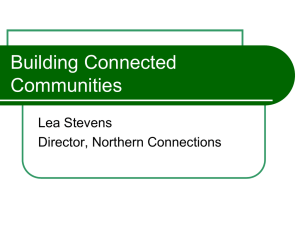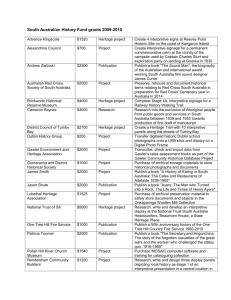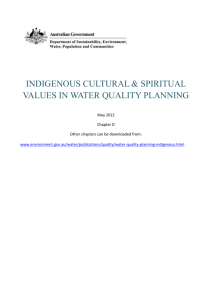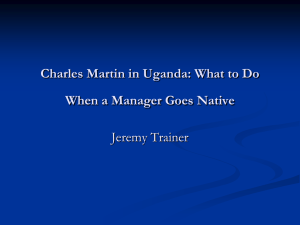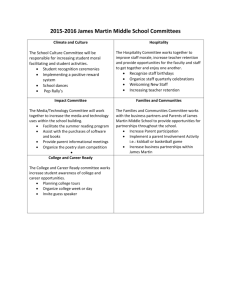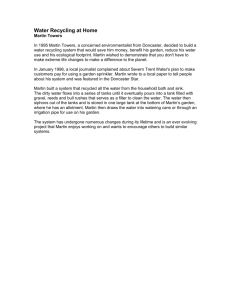James Martin & Co Phoenix Foundry
advertisement
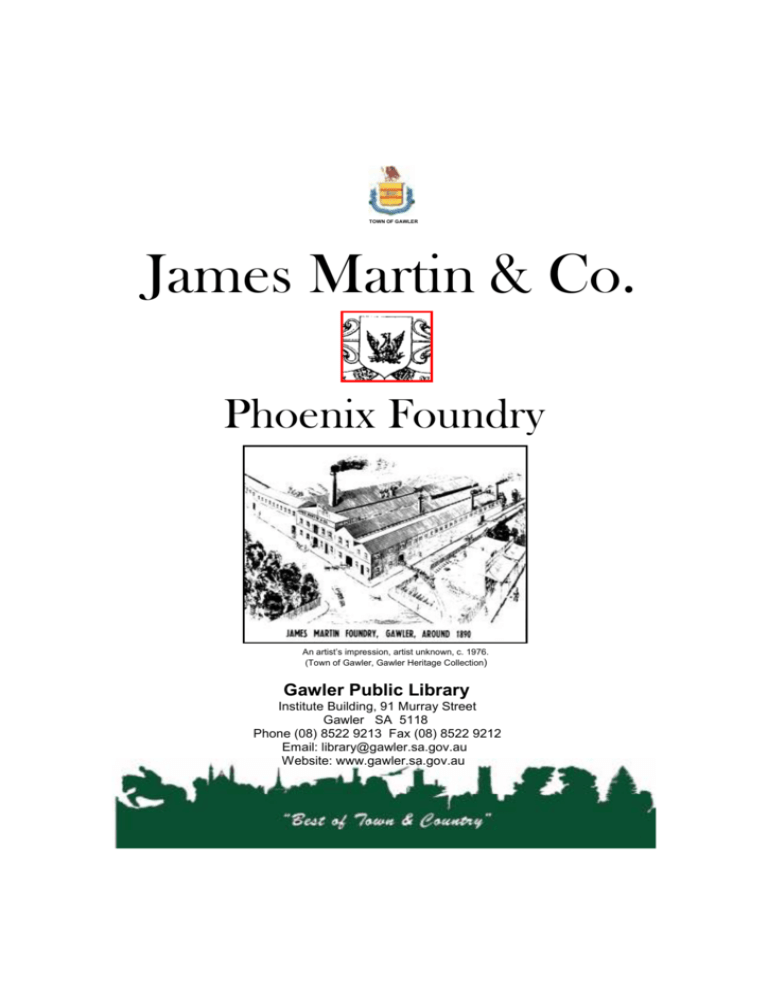
TOWN OF GAWLER James Martin & Co. Phoenix Foundry An artist’s impression, artist unknown, c. 1976. (Town of Gawler, Gawler Heritage Collection) Gawler Public Library Institute Building, 91 Murray Street Gawler SA 5118 Phone (08) 8522 9213 Fax (08) 8522 9212 Email: library@gawler.sa.gov.au Website: www.gawler.sa.gov.au 2. The name ‘Phoenix Foundry’ has been in use since the 1860s and possibly even earlier. It was not formally used: it was not registered as a business name nor did it appear on signage on the building.1. Nevertheless, the foundry was a leading engineering works in South Australia in the late nineteenth century when Gawler was one of Australia’s most important industrial centres. The building façade is significant because it is “a rare example of later Colonial industrial architecture” and is “a scarce representative of Gawler’s industrial area”.2. James Martin, the man responsible for the development of the Phoenix Foundry, arrived in Gawler in June,1848. He had arrived with the first of his three wives, in South Australia in July, 1847 and quickly found employment with John Ridley, the manufacturer of the Ridley reaper. In an unpublished document, James Martin described how he decided to start his own business and selected Gawler because “it was then said that South Australia was north of Adelaide and Gawler was the key to the North”. He goes on to say that he chose Gawler also because it was “well-watered” and therefore suitable for becoming a manufacturing centre. He viewed Gawler as a place of possible growth even though at that time it was ‘simply a bush town’ through which all of the Burra Burra traffic went.3. On arrival at Gawler, James Martin rented a small shop which was part of the Old Spot Hotel and set up business as a blacksmith and wheelwright. One of his first tasks was to cut down a tree and from the timber, he constructed benches to work on, and a lathe, using the tools he had brought from Cornwall.4. Despite initial opposition from the only other blacksmith (a man named Johnson) in the town, the business prospered and by 1851 he employed about 30 men. In that same year, gold was discovered in Victoria and men flocked east in search of their fortune. By Christmas that year, as the legend goes, only five adult males were left in Gawler. James Martin was one of those who made the trek to the goldfields but returned after a short time to Gawler to re-establish his business.5. From humble beginnings, James Martin’s business progressed to one which employed over 600 men and had an annual turnover of £150,000.6. James Martin’s business had begun with the building of bullock drays but after 1. Grieve Gillett Architects Former James Martin & Co Phoenix Foundry: Conservation Management Plan, Adelaide, 2003, p. 16. 2. Phoenix Foundry (former) Calton Rd, Gawler East, SA, Australia, www.environment.gov.au, accessed 12/11/09. 3. A few memoirs of the history of James Martin of Gawler South Australia, January 19th 1896, copy held in Local History Collection, Gawler Public Library. 4. George E. Loyau The Representative Men of South Australia, Adelaide, 1880, p. 165. 5. Grieve Gillett Former James Martin & Co, p. 16. 6. Leslie S Duncan Colonial Athens: Centenary 1839-1939, Gawler, 1939. 3. his return from the goldfields, he began also to manufacture agricultural implements, primarily reapers. He had an understanding of agriculture and this enabled him to realise, and cater for, the needs of pioneer farmers by providing implements suited to the unique conditions of South Australia. The arrival of the railway from Adelaide in 1857 allowed for business expansion as access to the Adelaide markets became easier. In 1858, Thomas Flett Loutit, an engineer, joined James Martin as business partner. During his time with the business, Loutit introduced improved machinery and steam power to the workshops.7. The partnership was dissolved in 1868 due to Loutit’s ill health but this did not adversely affect the business which, to the contrary, continued to expand. Source: Daryl R Needham and Daryl I Thomas Men of Metal: a Chronicle of the Metal Casting Industry in South Australia 1836-1986 From 1869 to 1871, James Martin acquired the land he needed for a new foundry on Calton Road between High and Duffield Streets. By 1880 the acquisition was complete and the foundry, consisting of workshop, yards and offices, had been constructed.8. During this period, the business was continually expanding and in 1873 it employed 95 men.9. Also, during this period James Martin’s nephew, John Felix Martin, joined him in partnership, as did Fred May who had previously been the superintending engineer at Moonta Mines. With this new partnership came a new name: James Martin & Co.10. Using Fred May’s mechanical skills and experience with mining machinery, the company moved into the production of large pumping equipment, heavy ore crushing plant and winch drums. During the early 1870s the foundry had the honour of smelting the first iron ore from the Barossa Valley.11. 7. Grieve Gillett Former James Martin & Co, p. 14. 8. Ibid, p. 18. 9. Loyau The Representative Man of South Australia, p. 166. 10. Grieve Gillett Former James Martin & Co, p. 18. 11. Ibid. 4. The first locomotive manufactured by James Martin & Co. at Gawler, 11 April 1890. (Town of Gawler, Gawler Heritage Collection) During 1885, Fred May left the company to commence business with his brother. His departure, as with Thomas Loutit’s before him, did not adversely affect business and by 1888 James Martin had acquired more land to the south of the foundry. In that year, the company secured a contract for the manufacture of 52 locomotive engines for the South Australian government. This was followed two years later with another contract for a further 92 engines. Employee numbers had grown to 420 by 1888 and by the early 1890s had reached 700. The output of the foundry was enormous and, on one day in 1897, ‘39 truckloads of machinery were dispatched from the works, weighing more than 200 tons and having a value upwards of £10,000’.12. On 11 April 1890, the town of Gawler celebrated as the first locomotive produced in South Australia rolled out of James Martin & Co.’s workshop. The Governor of South Australia and many other dignitaries were in attendance for the Gala Day which ended with fireworks in the evening.13. By December 1894, the onehundredth locomotive was delivered. Record levels of production were achieved by James Martin & Co. in 1896.14. Towards the end of the 1890s, business for James Martin & Co. began to decline as the South Australian Railways commenced building their own rolling stock and orders for steam boilers ceased. Output dropped, men were laid off and when James Martin died on 27 December 1899, anxiety about the future of the 12. E H Coombe History of Gawler 1837-1908, Adelaide, 1910, p. 95. 13. ‘Gawler’s first locomotive’, The Bunyip, 11 April 1890. 14. Grieve Gillett Former James Martin & Co, p. 23. 5. business was high.15. New government contracts were secured in the first few years of the twentieth century for bridges, boilers and valve castings and for a short time the business looked secure although it would never again employ more than 400 workers at any one time.16. Increasing competition, particularly from May Brothers, together with a heavy debt burden, led shareholders to pass a motion in August 1907 for the voluntary liquidation of the company.17. After liquidation the works were divided into two separate companies which helped to relieve the devastating effect on the people and the economy of Gawler. Local farmers and businesses formed the Gawler Implement Manufacturing Co. to carry on the agricultural part of the business. The major part of the former James Martin & Co. was acquired by Henry Dutton, son-in-law of John Felix Martin (and father of Geoffrey Dutton, author). He took over the debts and injected much-needed working capital into the engineering section and foundry which he continued to operate under the name of James Martin & Co.18. The State government awarded Henry Dutton a contract for 10 locomotives and 100 goods wagons. This enabled the foundry to begin operations again and new contracts coming in allowed the foundry to continue working but only 250 men were employed. Another government contract for 140 railway trucks was secured in May 1910 and in July of that same year the company was awarded another contract for 22 locomotives and louvred vans. Later in that same year also, the company won another contract for 21 narrow gauge locomotives. Henry Dutton died in 1914 but the business continued to operate and in March 1915 received orders for 12 narrow gauge boilers.19. James Martin & Co., ca. 1905 (Town of Gawler, Gawler Heritage Collection) 15. 16. 17. 18. 19. Ibid, p. 29. Ibid. Ibid. Ibid. Ibid, p. 30. 6. On 7 April 1915, Samuel Perry purchased the foundry and set up Perry Engineering, taking over the existing contracts for supply of locomotives to the Commonwealth, South Australian and Tasmanian governments. However, Perry Engineering failed to win the large contracts required to keep the foundry viable and it closed in July 1928, with devastating effect to employment and business in Gawler. In 1932, most of the buildings were demolished and the material was removed. As the last load departed on 3 June 1932, The Bunyip reported ‘as the trucks were pushed out along the main line in Murray Street, workmen were engaged in pulling up the rail lines’.20. The ownership of the property remained with Perry Engineering until 1946, after which time the land was sold off in parts until 1996, when a large portion of it was re-consolidated under the ownership of Chamberlain Investments Pty Ltd. Since 1946, the site has been used for a number of purposes including spring works, a car yard, ice works, a milk factory and for storage of heavy earth moving equipment.21. James Martin & Co., date unknown. (Town of Gawler, Gawler Heritage Collection) 20. ‘Perry’s last load’, The Bunyip, 3 June 1932. 21. Grieve Gillett Former James Martin & Co , pp. 32-34. 7. In 2008-09, the site underwent major changes when it was bought by the developer DayCorp and re-developed as Phoenix Plaza. The $30 million shopping precinct contains a major retail outlet and 19 specialty stores. The heritage façade was retained and refurbished for use as commercial office suites. Phoenix Plaza, Calton Road, Gawler East, 2009 (Town of Gawler, Gawler Heritage Collection) Phoenix Plaza, Calton Road, Gawler East, 2009 (Town of Gawler, Gawler Heritage Collection) 8. Part of Century Exhibition Adelaide, March 1900 (Town of Gawler, Gawler Heritage Collection) References A Few Memoirs of the History of James Martin of Gawler South Australia, January 19th 1896, copy held in Local History Collection, Gawler Public Library. Coombe, E H History of Gawler 1837-1908, Adelaide, Vardon & Sons, 1910. Duncan, Leslie S Colonial Athens: Centenary 1839-1939, Gawler, Gawler Centenary Fund, 1939. ‘Gawler’s first locomotive’, The Bunyip, 11 April 1890. Grieve Gillett Architects Former James Martin & Co Phoenix Foundry: Conservation Management Plan, Adelaide, 2003. Loyau, George E. The Representative Men of South Australia, Adelaide, Goodfellow & Hele 1880. ‘Perry’s last load’, The Bunyip, 3 June 1932. Phoenix Foundry (former) Calton Rd, Gawler East, SA, Australia, www.environment.gov.au, accessed 12/11/09. Researched and written by Anne Richards, Librarian, Reference and Research Services Number 21 in a Series of Historical Pamphlets produced by Gawler Public Library © 2009 Gawler Public Library
